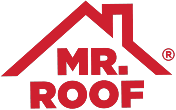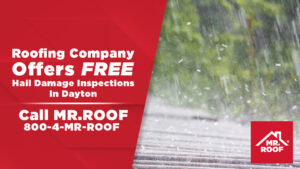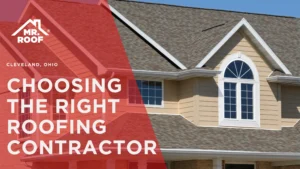Severe storms can turn a minor roof issue into a major disaster within minutes. Dayton homeowners face this reality each season as unpredictable weather patterns threaten their homes’ first line of defense. Mr. Roof understands these challenges and offers free roof inspections to help protect your investment.
Local Dayton roofers report that most storm damage could be prevented with proper preparation and timely maintenance. As a trusted Dayton roofing company, we’ve seen how regular inspections can identify potential weaknesses before they become costly repairs. Therefore, knowing your roof’s condition isn’t just about peace of mind—it’s about protecting your entire home.
This guide explains how to prepare your roof for severe weather, what to expect during a professional inspection, and the steps to take afterward. We’ll also cover insurance considerations and help you make informed decisions about your roof’s maintenance needs.
Why Storm-Readiness Matters for Dayton Roofs
The Ohio Valley’s weather landscape presents unique challenges for Dayton homeowners. From severe thunderstorms to unexpected snow events, your roof constantly battles the elements throughout the year. Consequently, understanding these weather patterns and potential damage types can help you prepare and protect your most valuable investment.
Dayton’s unpredictable weather patterns
Dayton’s geographic location makes it particularly vulnerable to rapid weather changes. The Great Lakes region can experience drastic shifts at any moment, with conditions transforming from calm to severe in minutes. While meteorologists provide forecasts, the intensity of storms can change suddenly, often becoming far worse than initially predicted.
Throughout the year, Dayton residents face diverse weather challenges:
- Spring and Summer: Hot, humid days with temperatures ranging from mid-70s to mid-80s Fahrenheit, frequently punctuated by afternoon thunderstorms
- Fall: Transitional weather with fluctuating temperatures and occasional severe storms
- Winter: Freezing temperatures, snowstorms, and ice accumulation that put significant strain on roofing systems
“The weather in Dayton, Ohio, can be a mixed bag of surprises, from thunderstorms and hail to fierce winds and heavy snow,” notes a local roofing expert. These conditions constantly test your home’s durability, especially your roof’s integrity.
Common types of storm damage in the region
Recent weather events highlight the risks Dayton roofs face. Spectrum News 1 confirmed that six tornados raked through Ohio, damaging commercial buildings, farms, and residences. Even properties outside the direct path experienced significant damage from straight-line winds that affected central and southern Ohio.
High winds represent one of the most common threats to Dayton roofs. These winds don’t impact your roof evenly—corners, edges, and ridge lines are particularly susceptible. Even seemingly intact shingles can be compromised when extreme winds create a suction effect, lifting shingles upward and loosening nails.
Hailstorms, although sometimes brief, leave lasting damage. From small dents to severe punctures, hail can significantly reduce your roof’s effectiveness and lifespan. Furthermore, even smaller hailstones gradually chip away at shingles by damaging protective granules and creating fractures.
Heavy rainfall presents its own set of challenges. Aging or damaged roofs often develop leaks after intense rain, leading to interior wall damage, mold, rot, and water pooling. Without proper drainage, standing water after heavy rainstorms can threaten both your roof and home interior, particularly in areas where the roof is uneven.
Winter brings additional concerns as thick ice and heavy snow strain roof structures. When temperatures fluctuate, melting snow can refreeze in gutters, forming ice dams that trap water under shingles. Over time, these dams can weigh down and compromise roof decks or rafters.
Perhaps most surprising, prolonged sun exposure weakens roofing materials between storms, making them more susceptible when severe weather strikes. Sun-damaged shingles often curl or fade, becoming brittle and less resilient.
Mr. Roof Dayton understands these regional challenges and specializes in identifying storm damage before it worsens. Their free inspection service helps Dayton homeowners assess potential vulnerabilities, especially important considering that “Even if your property is outside of the main destruction of a tornado, high winds and hail can still leave major damage”.
By preparing your roof for these regional weather challenges, you’re not just preventing property damage—you’re protecting your family and preserving your home’s value against Dayton’s unpredictable climate.
How to Prepare Your Roof Before a Storm
Being proactive about roof maintenance can mean the difference between minor repairs and major home damage. Prior to storm season, taking specific steps to fortify your roof against Dayton’s challenging weather conditions is absolutely essential. Let’s explore the critical pre-storm preparation tasks that protect your investment.
Inspect shingles and flashing for wear
Regularly checking your roof’s condition helps identify potential vulnerabilities before a storm exposes them. A thorough inspection should focus on several key components:
First, examine your shingles carefully. Look for any that are cracked, curled, blistered, or completely missing, as these damaged areas allow water to penetrate your home’s protective barrier. Pay close attention to loose or missing shingles, particularly around the roof’s edges and ridges where wind damage often begins. Additionally, inspect for improperly seated or “popped” nails that can create entry points for moisture.
Next, assess all flashing areas. Flashing—the metal sheathing around chimneys, vents, and skylights—prevents water from entering your home at these vulnerable points. Over time, flashing can rust, separate from surfaces, or develop cracks. Examine the caulking around flashing edges; peeling, cracking, or missing beads indicate maintenance is needed. Remember that aluminum flashing doesn’t rust but can still become compromised if fasteners loosen due to wood’s natural flexing.
As a safeguard, Mr. Roof Dayton offers professional roof inspections in Dayton that can identify these issues even if they’re not visible from ground level.
Clean gutters and downspouts
Your gutter system plays a crucial role in directing water away from your home during storms. When gutters are clogged with debris such as leaves, twigs, and dirt, they overflow, potentially causing significant water damage.
Begin by removing all debris from gutters and downspouts. Accumulated leaves and twigs prevent proper drainage, causing water to back up onto your roof and under shingles. This pooling water can eventually penetrate your home’s interior, leading to structural damage.
Moreover, check gutters for signs of damage including dents, cracks, or areas where they’ve pulled away from the roof. Inspect downspouts to ensure they’re securely fastened and properly directing water away from your foundation. Many trusted Dayton roofers emphasize that even small blockages can cause major issues during heavy rainfall.
For optimal protection, schedule gutter cleaning at least twice yearly—typically in late spring and early fall . This routine maintenance prevents costly water damage while preserving your home’s structural integrity.
Trim nearby trees and branches
Falling trees and branches cause approximately $1 billion in property damage annually. This startling statistic highlights why tree maintenance is essential for protecting your roof.
Start by trimming back any branches that overhang your roof, especially those that could break during high winds. Experts recommend maintaining at least six feet of clearance between branches and your roofline. This space helps prevent branches from scraping against shingles during windy conditions, which can strip away protective granules and create vulnerabilities.
Beyond preventing direct impact damage, regular tree trimming offers additional benefits. It improves airflow around your home, allowing your roof to dry more efficiently after rainfall. Furthermore, well-pruned trees become more aerodynamic, handling wind better with less chance of splitting or uprooting during severe weather.
Many Dayton Roofing Company professionals note that even small twigs and leaves from overhanging trees can clog gutters and drainage systems, compounding potential storm damage. If you’re uncomfortable performing this maintenance yourself, consider consulting with a professional arborist who can safely trim trees around your property.
By performing these three critical maintenance tasks before storm season, you’ll significantly reduce your risk of roof damage and costly repairs. Mr. Roof Dayton recommends completing these preparations at least once annually, preferably before Dayton’s most severe weather seasons.
What to Expect During a Free Roof Inspection
Professional roof inspections reveal critical information about your home’s first line of defense. When scheduling with Mr. Roof, you’ll experience a systematic assessment that could prevent minor issues from becoming costly repairs. Understanding this process helps you get maximum value from this essential service.
Visual assessment of shingles and structure
The inspection typically begins with a ground-level evaluation where inspectors use binoculars or drones to survey your entire roof surface. These tools allow professionals to spot visible damage like missing shingles, discoloration, or sagging areas without immediately climbing onto the roof. Undoubtedly, this preliminary assessment provides valuable insights before the closer examination begins.
Next, experienced Dayton roofers will inspect your roof up close, examining:
- Shingle condition – looking for cracks, curling, blistering, or granule loss
- Flashing and seals around chimneys, vents, and skylights
- Structural integrity – checking for sagging, deterioration, or warping
- Gutter systems – ensuring proper attachment and function
Notably, reputable Dayton Roofing Companies analyze all corresponding roofing components since issues often have a cascading effect. Professionals understand that seemingly minor problems might indicate more significant underlying concerns.
Checking for hidden damage
Beyond the obvious problems, skilled inspectors search for subtle signs of damage that untrained eyes might miss. Hidden roof damage often requires specialized knowledge and equipment to detect. According to industry practices, an inspector will check for moisture infiltration, which can compromise your roof’s structural integrity long before visible leaks appear.
Some Dayton roofers employ advanced technology like infrared imaging to identify concealed moisture issues. This technology can detect temperature differences that indicate water intrusion not visible from the surface. In fact, professionals sometimes inspect from inside your attic, looking for signs of water stains, mold, excessive moisture, or daylight coming through the roof boards.
Documentation and photo evidence
Throughout the inspection, comprehensive documentation creates a clear record of your roof’s condition. Many inspectors capture photographs of problem areas to illustrate their findings. These visual records prove invaluable for understanding the issues and potentially supporting insurance claims.
Following the assessment, you’ll receive a detailed report outlining your roof’s overall condition. This documentation typically includes specific problem areas, their severity, and recommendations for necessary repairs or maintenance. Mr. Roof provides clear, thorough reports that help homeowners understand exactly what issues exist and which require immediate attention.
The inspection report becomes your roadmap for maintaining your roof’s health. Understanding the severity of identified issues and potential repair costs helps you make informed decisions about protecting your home from Dayton’s unpredictable weather.
After the Inspection: What Happens Next?
Receiving your roof inspection report marks the beginning of informed decision-making about your home’s protection. This critical document serves as your roadmap for maintaining your roof’s health and longevity against Dayton’s challenging weather conditions.
Understanding your inspection report
Your inspection report typically includes several key sections worth reviewing immediately. First, look for the condition summary that provides an overall assessment of your roof’s health. Next, examine the recommendations section—one of the most valuable parts of the report that outlines specific actions based on the findings. Most reports include supporting photographs that highlight problem areas, making it easier to understand exactly what issues exist.
Mr. Roof provides detailed documentation with clear explanations of technical terms, ensuring you comprehend the current state of your roof. Their reports prioritize recommendations, indicating which issues require immediate attention versus those that can be addressed later.
Repair vs. replacement recommendations
Making the critical repair-or-replace decision depends on several factors. For roofs less than 10-15 years old with relatively minor damage, roof repairs are typically more cost-effective. However, if your roof is nearing the end of its lifespan or has extensive damage, full roof replacement often provides better long-term value.
Trusted Dayton roofers consider factors beyond just visible damage. The local climate plays a significant role—Dayton’s weather patterns might make certain materials more suitable than others. A comprehensive inspection report from a Dayton Roofing Company will outline whether repairs would be sufficient or if replacement offers better protection and value.
How to prioritize urgent fixes
Always address safety issues first—electrical hazards, structural concerns, or active leaks demand immediate attention. Indeed, these problems tend to worsen over time, especially in Dayton’s climate. Rather than delaying repairs, schedule them promptly, particularly before severe weather seasons.
For less urgent matters, consider:
- Addressing water-related issues before they cause interior damage
- Fixing structural concerns that could compromise your roof’s integrity
- Scheduling maintenance items like gutter cleaning or minor repairs
Mr. Roof Dayton can help categorize repairs based on urgency, providing peace of mind about which issues need immediate action. As roofing experts often emphasize, small problems left unaddressed typically become costly emergencies down the road.
Navigating Insurance and Choosing the Right Contractor
After discovering roof damage, navigating the insurance claims process and selecting a qualified contractor become your next critical steps. Many homeowners find these tasks overwhelming, yet approaching them systematically helps ensure your home receives proper repairs without unnecessary financial burden.
Filing a claim with proper documentation
The strength of your insurance claim often depends on the quality of your documentation. First of all, document everything thoroughly—take clear photos and videos of all visible damage immediately after the storm. Be prompt with your claim submission; the longer you wait, the more challenging it becomes to prove the damage resulted from a specific weather event.
While waiting for your claim to be processed, make temporary repairs to prevent further damage. Keep all receipts for these emergency fixes as your insurance may reimburse these costs. With this in mind, create a comprehensive file containing:
- High-resolution photos from multiple angles
- Videos showing the extent of damage
- Written descriptions of all affected areas
- Receipts for emergency repairs
- Maintenance records showing proper roof care
When the insurance adjuster visits, be present during their assessment to point out all damage areas. Many experts recommend having your chosen roofing contractor meet the adjuster at your property—this professional can identify damages the adjuster might miss.
Questions to ask your roofing contractor
Selecting a reputable Dayton roofing company requires careful vetting. At minimum, verify that potential contractors have both liability insurance and workers’ compensation coverage. Without these protections, you could be financially responsible for accidents or further property damage.
Mr. Roof recommends asking contractors these essential questions:
- “Can you provide proof of proper licensing and insurance?”
- “How long have you been in business in the Dayton area?”
- “What warranties do you offer on materials and workmanship?”
- “Will you provide a detailed written estimate including all costs?”
- “Who will actually perform the installation—employees or subcontractors?”
Legitimate Dayton roofers willingly provide documentation of their credentials and references from recent projects. Be wary of contractors who seem reluctant to answer questions or provide minimal detail in their estimates.
Before signing any contract, ensure it contains the complete scope of work, materials to be provided, payment terms, and the contractor’s contact information. Remember that the contractor you choose influences every aspect of your roofing project.
Conclusion
Storm damage threatens Dayton homes year-round, making professional roof maintenance essential rather than optional. Regular inspections serve as your first defense against severe weather, potentially saving thousands in repair costs while protecting your family and property.
Preparation proves vital – from examining shingles and clearing gutters to maintaining nearby trees. These simple yet crucial steps significantly reduce your risk of major storm damage. Most importantly, addressing small issues promptly prevents them from becoming expensive emergencies during severe weather.
Trusted local roofing experts like Mr. Roof understand Dayton’s unique weather challenges and provide thorough inspections that identify potential problems before storms strike. Their detailed reports help homeowners make informed decisions about repairs or replacement, ensuring your roof remains ready for whatever weather comes next.
Remember, proper documentation and choosing qualified contractors safeguard both your home and your insurance claims. Smart homeowners recognize that investing in preventive maintenance today prevents costly repairs tomorrow, especially considering Ohio’s unpredictable weather patterns.









